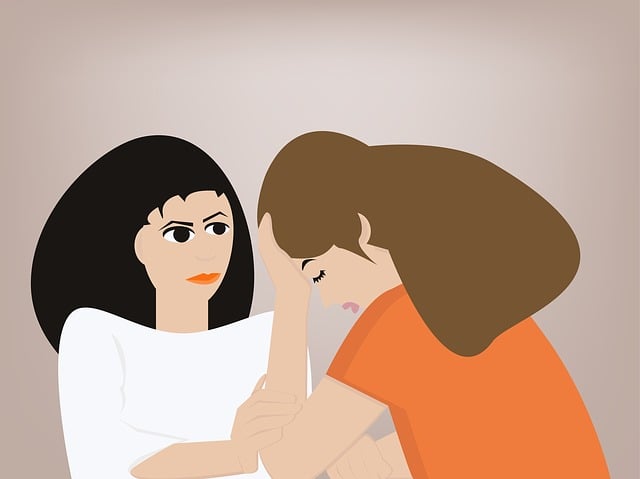Castle Rock Postpartum Depression Therapy: Stress Reduction for New Mothers
New mothers facing stress and mental health challenges post-childbirth can turn to Castle Rock Postp…….
In the realm of mental health support, specialized therapy programs have emerged as powerful tools for addressing specific challenges, particularly in new mothers. Among these, Castle Rock Postpartum Depression Therapy (CRPDT) has gained significant attention and importance in recent years. This therapeutic approach is tailored to combat postpartum depression, a condition that affects countless women worldwide following childbirth. In this article, we embark on an in-depth exploration of CRPDT, delving into its definition, history, global impact, economic implications, technological integrations, regulatory landscape, challenges, case studies, and future prospects. By the end, readers will possess a comprehensive understanding of this vital therapy and its role in empowering new mothers.
Definition: Castle Rock Postpartum Depression Therapy (CRPDT) is an intensive, specialized form of psychotherapy designed to support women experiencing postpartum depression and anxiety. It is named after the idea of fortifying and supporting individuals, similar to how a castle provides protection and stability. CRPDT focuses on addressing the unique psychological and emotional challenges that arise during and after pregnancy.
Core Components:
Individualized Assessment: Each therapy session begins with a comprehensive assessment tailored to the mother’s experiences. This includes discussing symptoms, triggers, and personal circumstances.
Cognitive Behavioral Therapy (CBT): CRPDT heavily incorporates CBT techniques to identify and challenge negative thought patterns associated with postpartum depression. By reframing these thoughts, mothers can develop healthier coping mechanisms.
Mindfulness Practices: Mindfulness meditation and breathing exercises are integral parts of CRPDT. These practices help reduce stress, improve focus, and enhance overall well-being.
Supportive Environment: The therapy sessions create a safe, non-judgmental space for mothers to express their feelings openly. This supportive environment encourages vulnerability and fosters trust.
Education and Skill-Building: CRPDT equips mothers with valuable skills to navigate postpartum challenges. This includes stress management techniques, effective communication strategies, and self-care practices.
Historical Context: The concept of specialized postpartum support therapy gained traction in the early 2000s as research highlighted the unique nature of postpartum depression. Traditional mental health approaches often failed to address the specific needs of new mothers. In response, CRPDT emerged as a targeted intervention, drawing from various therapeutic modalities to create an effective and compassionate treatment model.
Postpartum depression is a universal concern, affecting women across diverse cultures and socioeconomic backgrounds. According to the World Health Organization (WHO), an estimated 10-15% of new mothers worldwide experience postpartum depression, with varying regional rates:
| Region | Prevalence Rate |
|---|---|
| North America | 10-15% |
| Europe | 12-18% |
| Asia | 15-20% |
| Africa | 7-12% |
Castle Rock Postpartum Depression Therapy has gained international recognition and adoption due to its proven effectiveness. Key trends shaping its global impact include:
Increased Awareness: Growing awareness campaigns and initiatives have brought postpartum mental health issues into the spotlight, leading to greater acceptance of CRPDT as a viable solution.
Cultural Adaptation: Therapists worldwide are adapting CRPDT to suit local cultural contexts, ensuring cultural sensitivity and better patient engagement.
Integration with Healthcare Systems: Many countries are integrating CRPDT into their primary healthcare systems, making it more accessible to women who need support.
The economic implications of Castle Rock Postpartum Depression Therapy are multifaceted:
Market Dynamics: The global mental health market is experiencing significant growth, driven by increasing awareness and investment in specialized therapies. CRPDT, as a niche within this market, benefits from rising demand for effective postpartum support.
Investment Patterns: Private investors and healthcare organizations are increasingly funding research and development in CRPDT, leading to advancements in therapy delivery and improved outcomes.
Cost-Effectiveness: Studies demonstrate that early intervention through CRPDT can reduce long-term healthcare costs associated with severe postpartum depression. This includes fewer hospitalizations and repeated medical interventions.
Productivity and Employment: By supporting new mothers’ mental health, CRPDT contributes to increased productivity and employment rates. Healthy and supported mothers are better equipped to return to work or pursue parental leave responsibilities.
Technology plays a pivotal role in enhancing Castle Rock Postpartum Depression Therapy:
Telehealth Platforms: The rise of telehealth has made CRPDT more accessible, especially in remote areas. Online therapy sessions allow mothers to receive support from the comfort of their homes, reducing barriers to care.
Mobile Applications: Dedicated mobile apps offer valuable resources for CRPDT, including mood tracking, mindfulness exercises, and educational content. These tools empower mothers to actively participate in their therapy between sessions.
Virtual Reality (VR) Therapy: VR technology is being explored as a novel way to expose patients to gradual, controlled stressors in a safe environment. This can be particularly beneficial for exposure therapy techniques within CRPDT.
Artificial Intelligence (AI): AI-powered chatbots and virtual therapists assist in screening and initial assessments, providing immediate support and guidance to mothers experiencing early signs of postpartum depression.
The regulatory landscape surrounding Castle Rock Postpartum Depression Therapy varies across regions:
North America: In the United States, CRPDT falls under the umbrella of mental health services, regulated by state licensing boards. The American Psychological Association (APA) provides guidelines for therapeutic practices, ensuring quality and ethical standards.
Europe: Each European country has its own regulatory body overseeing mental health professions. For instance, in the UK, the Health and Care Professions Council (HCPC) regulates therapists, while in Germany, the Psychotherapeutenkammer (Chamber of Psychotherapists) sets standards.
Asia: In some Asian countries like Australia, CRPDT is regulated by the relevant mental health authorities, ensuring therapist qualifications and practice standards. Other nations are developing frameworks to standardize postpartum depression therapy.
Global Initiatives: Organizations like the World Federation for Mental Health (WFMH) advocate for policies promoting access to quality mental health services, including postpartum depression therapy, on a global scale.
Despite its potential benefits, Castle Rock Postpartum Depression Therapy faces several challenges:
Stigma and Misunderstanding: Stigma surrounding postpartum depression and therapy persists, deterring some mothers from seeking CRPDT. Educating the public and breaking down misconceptions are crucial steps.
Access to Therapists: The availability of qualified CRPDT therapists is limited in certain regions, creating barriers to access for eligible mothers. Addressing this requires targeted training programs and incentives for mental health professionals.
Cost and Insurance Coverage: Out-of-pocket costs for CRPDT can be a significant deterrent. Advocating for insurance coverage and exploring government funding models can improve accessibility.
Cultural Sensitivity: Ensuring cultural sensitivity in CRPDT is essential, as therapeutic approaches must align with diverse cultural beliefs and practices regarding mental health.
Solutions and Strategies:
Background: Sarah, a young mother in her late twenties, experienced severe postpartum depression after the birth of her first child. She lived in a rural area with limited access to mental health services.
CRPDT Intervention: Through a telehealth platform, Sarah connected with a licensed CRPDT therapist. The therapy sessions incorporated CBT techniques to challenge negative thoughts, mindfulness practices for stress reduction, and education on postpartum changes.
Outcomes: Within 8 weeks of starting CRPDT, Sarah reported significant improvements in her mood and overall well-being. She regained confidence in managing parenting challenges and resumed her part-time job. Sarah’s experience demonstrated the effectiveness of CRPDT in reaching mothers who might otherwise face barriers to traditional therapy.
Scenario: Jennifer, a new mother in an urban setting, struggled with anxiety and depression after childbirth. She was hesitant to seek professional help due to concerns about judgment from her social circle.
CRPDT Approach: A local community health center offered CRPDT sessions tailored to Jennifer’s needs. The therapy focused on building resilience through mindfulness, coping strategies, and social support networks. Sessions were conducted in a small group setting, fostering a sense of camaraderie among participants.
Results: Over 12 weeks, Jennifer gradually improved, learning effective ways to manage her anxiety. She built a supportive network of fellow mothers going through similar experiences. This case highlights the value of CRPDT in creating safe, community-based support systems.
The future of Castle Rock Postpartum Depression Therapy holds immense potential:
Personalized Therapy: Advancements in technology and research will enable more personalized CRPDT, leveraging individual differences and preferences to enhance therapy outcomes.
Integrated Care Models: Collaboration between primary care providers, midwives, and mental health professionals can ensure comprehensive postpartum support, with CRPDT as a key component.
Global Expansion: With increasing awareness and evidence-based practices, CRPDT is expected to gain widespread adoption worldwide, reaching more mothers in need.
Research and Evidence Base: Ongoing research will strengthen the evidence base for CRPDT, informing clinical practice and policy decisions.
Castle Rock Postpartum Depression Therapy represents a significant advancement in supporting new mothers’ mental health. Its ability to address postpartum depression with targeted, evidence-based approaches has had a profound impact globally. By navigating challenges, embracing technological advancements, and advocating for policy changes, CRPDT continues to evolve as a crucial component of comprehensive healthcare systems. As awareness and understanding grow, this therapy will undoubtedly play an even more vital role in fostering the well-being of mothers and their families worldwide.
Q: How do I know if I need Castle Rock Postpartum Depression Therapy?
A: If you’re experiencing persistent sadness, anxiety, or mood swings following childbirth, along with changes in appetite, sleep patterns, or difficulty bonding with your baby, it might be a sign of postpartum depression. Consult a healthcare professional for an assessment to determine if CRPDT is suitable for you.
Q: Is CRPDT only for new mothers?
A: While CRPDT is primarily focused on supporting mothers after childbirth, it can also benefit women who have experienced pregnancy loss or adoption. The therapy’s goal is to address emotional challenges related to significant life transitions associated with parenthood.
Q: Can CRPDT be combined with other treatments?
A: Yes, CRPDT can often be integrated with other therapeutic modalities or medical interventions. For instance, it may be combined with medication for postpartum depression under the supervision of a healthcare provider. This multimodal approach can enhance overall treatment effectiveness.
Q: How long does CRPDT usually last?
A: The duration of CRPDT varies depending on individual needs and progress. Typically, therapy sessions continue until symptoms are significantly improved or resolved. This may range from several weeks to a few months.
Q: Is CRPDT covered by insurance?
A: Insurance coverage for CRPDT varies by region and provider. Some insurance plans include mental health services as part of their benefits. It’s essential to check with your insurance provider and understand your specific coverage before starting therapy.

New mothers facing stress and mental health challenges post-childbirth can turn to Castle Rock Postp…….

New mothers in Castle Rock often face stress and potential postpartum depression, impacting daily li…….

Castle Rock has pioneered specialized therapy programs to tackle postpartum depression (PPD) head-on…….

Castle Rock Postpartum Depression Therapy combines evidence-based strategies such as Mental Illness…….

New mothers experiencing past trauma face heightened emotional risks post-delivery, increasing the l…….

Mental health conditions like depression and anxiety can severely impact social interactions and qua…….

Diagnosing mental illnesses, especially Castle Rock postpartum depression therapy, accurately is cha…….